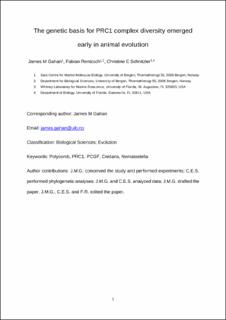| dc.contributor.author | Gahan, James | |
| dc.contributor.author | Rentzsch, Fabian | |
| dc.contributor.author | Schnitzler, Christine E. | |
| dc.date.accessioned | 2021-05-07T12:16:47Z | |
| dc.date.available | 2021-05-07T12:16:47Z | |
| dc.date.created | 2020-11-25T13:14:25Z | |
| dc.date.issued | 2020 | |
| dc.Published | Proceedings of the National Academy of Sciences of the United States of America. 2020, 117 (37), 22880-22889. | |
| dc.identifier.issn | 0027-8424 | |
| dc.identifier.uri | https://hdl.handle.net/11250/2754177 | |
| dc.description.abstract | Polycomb group proteins are essential regulators of developmental processes across animals. Despite their importance, studies on Polycomb are often restricted to classical model systems and, as such, little is known about the evolution of these important chromatin regulators. Here we focus on Polycomb Repressive Complex 1 (PRC1) and trace the evolution of core components of canonical and non-canonical PRC1 complexes in animals. Previous work suggested that a major expansion in the number of PRC1 complexes occurred in the vertebrate lineage. We show that the expansion of the Polycomb Group RING Finger (PCGF) protein family, an essential step for the establishment of the large diversity of PRC1 complexes found in vertebrates, predates the bilaterian–cnidarian ancestor. This means that the genetic repertoire necessary to form all major vertebrate PRC1 complexes emerged early in animal evolution, over 550 million years ago. We further show that PCGF5, a gene conserved in cnidarians and vertebrates but lost in all other studied groups, is expressed in the nervous system in the sea anemone Nematostella vectensis, similar to its mammalian counterpart. Together this work provides a framework for understanding the evolution of PRC1 complex diversity and it establishes Nematostella as a promising model system in which the functional ramifications of this diversification can be further explored. | en_US |
| dc.language.iso | eng | en_US |
| dc.publisher | National Academy of Sciences | en_US |
| dc.title | The genetic basis for PRC1 complex diversity emerged early in animal evolution | en_US |
| dc.type | Journal article | en_US |
| dc.type | Peer reviewed | en_US |
| dc.description.version | acceptedVersion | en_US |
| dc.rights.holder | Copyright 2020 The Authors | en_US |
| cristin.ispublished | true | |
| cristin.fulltext | postprint | |
| cristin.qualitycode | 2 | |
| dc.identifier.doi | 10.1073/pnas.2005136117 | |
| dc.identifier.cristin | 1852215 | |
| dc.source.journal | Proceedings of the National Academy of Sciences of the United States of America | en_US |
| dc.source.40 | 117 | |
| dc.source.14 | 37 | |
| dc.source.pagenumber | 22880-22889 | en_US |
| dc.identifier.citation | Proceedings of the National Academy of Sciences of the United States of America. 2020, 117 (37), 22880-22889 | en_US |
| dc.source.volume | 117 | en_US |
| dc.source.issue | 37 | en_US |
